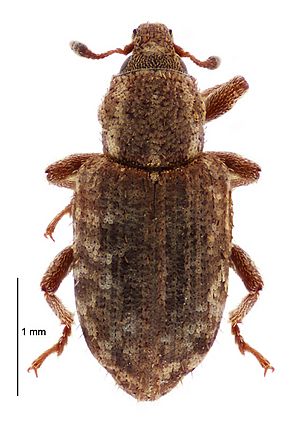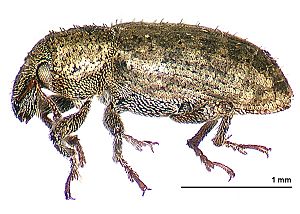Argentine stem weevil facts for kids
Quick facts for kids Argentine stem weevil |
|
|---|---|
 |
|
 |
|
| Scientific classification | |
| Kingdom: | |
| Phylum: | |
| Class: | |
| Order: | |
| Family: | |
| Subfamily: |
Cyclominae
|
| Genus: |
Listronotus
|
| Species: |
L. bonariensis
|
| Binomial name | |
| Listronotus bonariensis (Kuschel, 1955)
|
|
| Synonyms | |
|
Hyperodes bonariensis Kuschel, 1955 |
|
The Listronotus bonariensis is a type of weevil that originally comes from South America. It's better known as the Argentine stem weevil. This small insect is a common pest for grasses and cereal crops like wheat and barley. While adult weevils can cause some damage, their young (called larvae) are much more destructive. This weevil has spread to countries like Australia and New Zealand, where it causes big problems for farmers.
Contents
What Does the Argentine Stem Weevil Look Like?
The Argentine stem weevil is a tiny, grey insect, only about 3 millimeters (0.12 inches) long. It has a waxy coating on its body. This wax helps soil particles stick to it, which makes the weevil very good at blending in with its surroundings. When it stays still, it's really hard to spot! The young weevils, or larvae, are cream-colored grubs with brownish heads.
Where Do Argentine Stem Weevils Live?
This weevil first came from South America, where you can find it in countries like Brazil, Uruguay, Argentina, Bolivia, and Chile. In these places, it doesn't usually cause big economic problems for farmers.
However, the Argentine stem weevil has traveled to other parts of the world, including Australia and New Zealand. In these new homes, it has become a serious pest. In New Zealand, it's even considered the most important insect pest. Back in 1991, the damage it caused was estimated to be between NZ$78 million and NZ$251 million each year!
How Do Argentine Stem Weevils Affect Plants?
These weevils feed on many different farm plants. They especially like perennial ryegrass, which is a major crop they damage. They also eat Italian ryegrass, other types of grasses, wheat, barley, oats, and maize (corn).
Damage Caused by Weevils
Adult weevils make small, window-like holes in plant leaves. But it's the larvae that do the most harm.
- Eggs and Larvae: Female weevils lay groups of up to five tiny eggs, usually in a single row. The eggs are less than 1 millimeter (0.04 inches) long and start yellow, then turn darker. They hatch after one to two weeks.
- Damage to Wheat and Maize: In wheat fields, young plants can be killed by the larvae. Older plants might grow smaller, have weaker roots, and produce fewer tillers (new shoots). This problem is worse in fields where the soil isn't tilled (plowed) much, because this can encourage wild grasses and weeds that the weevils also like to eat. Young maize plants can also be badly damaged.
- Damage to Ryegrass: When eggs are laid on perennial ryegrass, the newly hatched larvae dig into the stem. As a larva grows through its four stages, it burrows through the plant. One larva can destroy up to five tillers! Usually, only one larva is found in each tiller.
Controlling the Weevil
Scientists in New Zealand have tried to control the Argentine stem weevil using biological control. This means using natural enemies to fight the pest.
- Wasp Helpers: One type of wasp, called Microctonus hyperodae, is a natural enemy of the weevil in South America. This wasp has been brought to New Zealand to help control the weevil, and it seems to be working in some areas. Another wasp, Microctonus aethiopoides, was brought in to control a different weevil, but it also helps by attacking the Argentine stem weevil.
- Helpful Fungi: Some special fungi, especially Acremonium species, have also been studied. These fungi live inside the crop plants. When they are present, they can stop the weevils from laying eggs and reduce the damage caused by the larvae. However, one type of fungus, Acremonium lolii, can make perennial ryegrass unsafe for farm animals to eat at certain times, which could make them sick.
See Also
Images for kids



